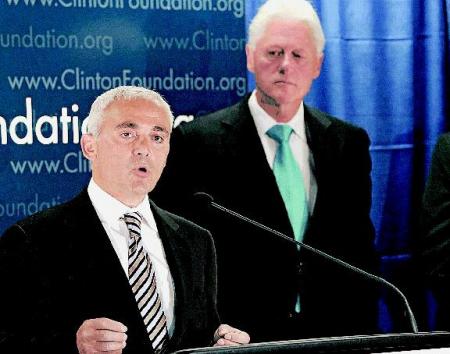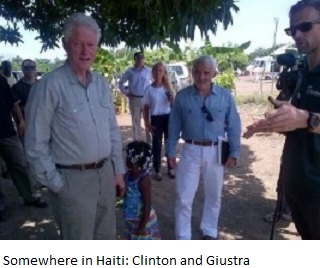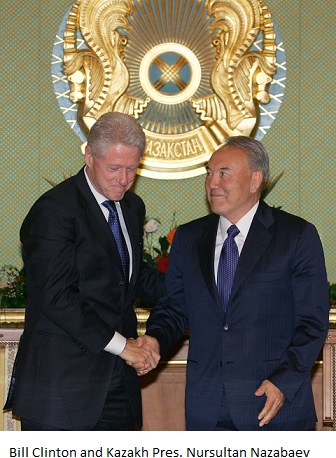Haiti: a toy in the play
CSMS Magazine Staff Writers
In case anyone wasn’t paying attention, Nursultan Nazarbaev has just won reelection with—listen to this—98 percent of the vote. He has been the absolute ruler of the former Soviet republic of Central Asia since 1989 when the country gained independence, like the rest of the 15 republics following the dissolution of the USSR. Before then, he was the Soviet party boss there.
Kazakhstan is the largest country in Central Asia and it sits on a vast, endless wealth of natural resources—from oil to diamond to uranium. So rich is Kazakhstan that Nazarbaev—commonly known as the snow-leopard of Central Asia—in 1997 moved all sites of government buildings and the headquarters of all strategic entities like sports, education to Akmola, a town sprawled on the banks of the mighty Ishim River on northeastern Kazakhstan. Nazarbeav then renamed the city to Astana which, in the Kazakh language, means “The Capital.” Astana then replaced Almaty—the former capital and the country’s largest city. Astana is today a dazzling hub—paradisiacal—which serves as the gateway to Asia, a megalopolis in Eurasia.
Ordinarily, this story would not have made such a splash, for Kazakhstan still remains under heavy Russian influence and close to 50% of the population is ethnic Russian. What brought the story to the forefront was that, according to New York Times reporter Joe Becker who reported last week, in 2005, Bill Clinton traveled to Astana with Canadian billionaire Frank Guistra—an adventurer and pioneer of the modern silk road of Central Asia. Guistra was reportedly seeking to purchase uranium mines there. The Clintons have been under heavy criticisms lately for their out-of-the norm fundraising practices on behalf of their foundation.
According to Becker, “Frank Guistra and Clinton were ‘wisked’ to the presidential palace. While there, Clinton ‘endorsed’ progress that Kazakhstan has made on its democracy……” Later, Clinton went on a lavish “press conference” in the glamorized Kazakh capital “with Nazarbaev by his side where he praised the president’s human rights records.”
 This story is elaborated further in the upcoming The Clinton Cash by Peter Schweizer, who confirmed that “in the end, Guistra was able to proceed with the uranium deal. Soon after that, the Clinton Foundation received a 31 million dollars donation from Guistra. But that initial donation seemed to have been the icy on the cake. In May of 2007, Guistra was one of four distinguished chairs of the 2006 Global Leadership Awards dinner in New York. It was an event organized to honor Bill Clinton as well as outgoing UN Secretary General Kofi Annan. That was in May.
This story is elaborated further in the upcoming The Clinton Cash by Peter Schweizer, who confirmed that “in the end, Guistra was able to proceed with the uranium deal. Soon after that, the Clinton Foundation received a 31 million dollars donation from Guistra. But that initial donation seemed to have been the icy on the cake. In May of 2007, Guistra was one of four distinguished chairs of the 2006 Global Leadership Awards dinner in New York. It was an event organized to honor Bill Clinton as well as outgoing UN Secretary General Kofi Annan. That was in May.
In June 2007, Giustra joined with Clinton to launch the Clinton Giustra Enterprise Partnership to address global poverty. Giustra committed $USD 100 million plus half of what he makes in the resource industry for the rest of his life. Carlos Slim Helú, the Mexican businessman and richest person in the world, made a matching contribution and Giustra is expected to enlist others in the Canadian resource industry (Source: Wikipedia)
Haiti: a toy in the play
 In 2014, Guistra and Clinton toured a peanut plantation in Haiti. According to Washington Post, “the Clinton Giustra Enterprise Partnership announced the launch of the Acceso Peanut Enterprise Corporation, which aimed to help more than 12,000 peanut farmers in Haiti.” This was a way to keep in check his proxies in Port-au-Prince and to keep a firm eye on Haiti’s mine exploration, a movement that has already been directed by Hillary’s younger brother Tony Rodham. Every single news report has reported that Tony Rodham knows nothing about mine exploration. Yet, he is the one ordering the crazies in Port-au-Prince.
In 2014, Guistra and Clinton toured a peanut plantation in Haiti. According to Washington Post, “the Clinton Giustra Enterprise Partnership announced the launch of the Acceso Peanut Enterprise Corporation, which aimed to help more than 12,000 peanut farmers in Haiti.” This was a way to keep in check his proxies in Port-au-Prince and to keep a firm eye on Haiti’s mine exploration, a movement that has already been directed by Hillary’s younger brother Tony Rodham. Every single news report has reported that Tony Rodham knows nothing about mine exploration. Yet, he is the one ordering the crazies in Port-au-Prince.
Just like in Haiti, the quid pro quo is everywhere. Nazarbaev was lauded by Clinton, Guistra won the uranium deal and Clinton walked away with 31 million. Giustra went on to create UrAsia, which later became a major player in the mining business. In 2013, UrAsia was acquired by Russia’s Uranium One in a deal that required the Russsians to pay 3.1 billion in US dollars.
Like in Haiti, the Kazakh people are the ultimate losers. Unlike Haiti, the Kazakh ruler loves his country and has been heavily investing in its infrastructure. The project to turn Akmola into Astana was said to be the most lavish, grandiose and extravagant undertaking in one hundred years. The world finest architects were mobilized for the project, including Japanese Kisho Kurokawa who designed the master plan.
By the way, Astana will be the site of 2017 Winter Olympics. Here is a glimpse of Astana. Click on this link: Astana
As for the Haitian leaders, they’re just proxies completely beholden to their masters—nothing more.
Also see: Haiti may derail Hillary Clinton’s reelection bid
Like us on Facebook: www.facebook.com/csmsmagazine



FAUSSES ÉLECTIONS FINANCÉES PAR LA
COMMUNAUTÉ INTERNATIONALE OU RÉVOLUTION CULTURELLE
IMPOSÉE PAR LA MASSE HAÏTIENNE?
Ces jours-ci,
manifester dans les rues
connaît une vogue inaccoutumée.
On manifeste pour s’opposer à un
gouvernement établi en vue de la
conquête du pouvoir. Militants sincères,
que voulez-vous? De fausses élections
financées par la Communauté
Internationale ou un vrai changement imposé par la Masse. Nous autres, nous encourageons
une révolution culturelle.
La prise du pouvoir pour le pouvoir
ne suffit pas.Nous ne réussirons pas si nous n’arrivons pas à encadrer pacifiquement
un million de maniifestants dans les rues, à publier un nouveau contrat social,
à présenter au grand public des cadres qui inspirent entière confiance à tous.